

The first step in treating any active infestation is to physically remove all the pest insects with water.
It’s a common mistake to think that the fastest way to kill the pest insect is to apply a pesticide spray – but this actually isn’t the case! Many sprays don’t kill on contact, giving the pest insect time to potentially survive, develop resistance, and continue to produce offspring.
The fastest way to ensure the pest insect is dead is to remove it from the plant. We recommend washing the plant’s leaves with a wet washcloth or paper towel, or rinsing the plant on an angle to ensure that pests are knocked down the drain, not into the pot. Repeat this process regularly until your beneficial insects arrive.
Once you release your beneficial insects, discontinue the regular rinsing of the plant (you don’t want to rinse off the beneficials!) but do still keep an eye on the plant. You can and should spot clean any pest insects you see after beneficial insect release with a towel.
General Tips for All Pest Issues:
*The first step in treating any active infestation is to physically remove all the pest insects with water. We recommend washing the plant’s leaves with a wet washcloth or paper towel, or rinsing the plant on an angle. Repeat this process regularly until your beneficial insects arrive.
Once you release your beneficial insects, discontinue the regular rinsing of the plant (you don’t want to rinse off the beneficials!) but do still keep an eye on the plant. You can and should spot clean any pest insects you see after beneficial insect release with a damp towel.
Active Infestation
THRIPS
A comprehensive thrips treatment plan should include three predators to get every life stage of the thrips – but there are different predators you can choose from for these life stages. You’ll need one predator for the adults and teenagers (either lacewings or pirate bugs), one predator for the young larvae (cucumeris mites or swirskii mites) and one predator for the pupae in the soil (stratiolaelaps mites or nematodes). These predators should be applied fresh every two weeks for at least three treatments to ensure full eradication.
How do you choose between lacewings and pirate bugs? The short answer is they are both good predators! Pirate bugs tend to be somewhat more effective because they attack thrips for fun and not just food – they actually carry the dead thrips bodies around as trophies which is somewhat satisfying. However, they are more expensive (they tend to be about twice as much as lacewings). Lacewing larvae are also good thrips predators, and a benefit of them is they also eat other soft bodied insects such as aphids, mealybugs, scale and spider mite eggs. Pirate bugs are really more geared toward just thrips than the other pest insects.
If it’s in your budget, we recommend choosing pirate bugs for at least the first application to treat aggressively, and then switch to lacewings for the follow up applications.
How do you choose between cucumeris and swirskii mites? We recommend cucumeris above swirskii in all situations unless your grow temperature is above 85 degrees, in which case swirskii will be more effective.
When it comes to choosing between nematodes and stratiolaelaps soil mites, stratiolaelaps is more voracious and should be used for your first two applications, and then you can switch to one application of nematodes for longer term prevention.
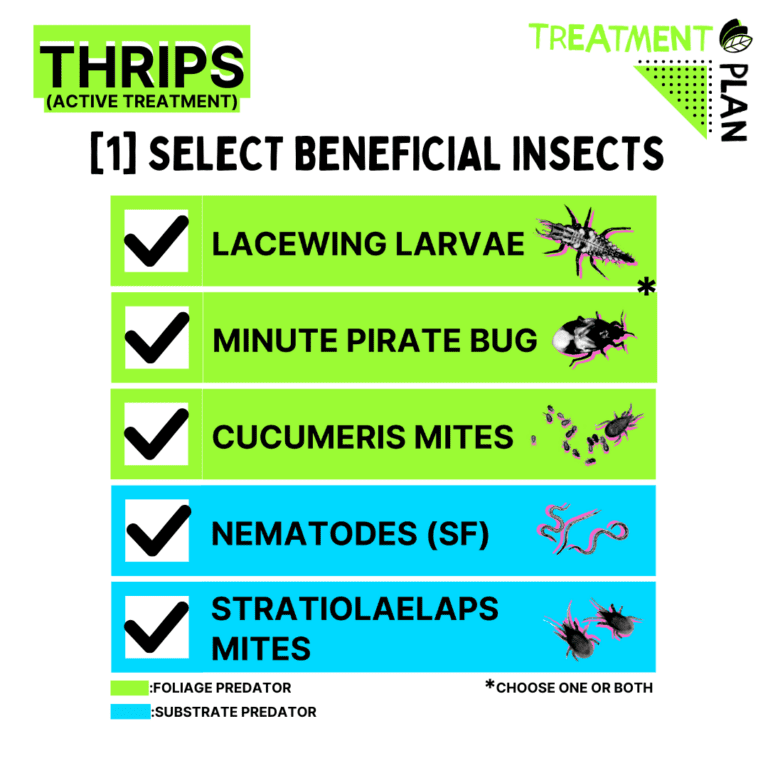

SPIDER MITES
Spider mites are among the easier houseplant pests to treat with beneficial insects! However people do find them very challenging if not impossible to treat with traditional pesticides. They are fairly resistant to most pesticide sprays (and many of these sprays, especially pyrethrins, actually cause their populations to “flare” or increase) as do systemic granules, which increase spider mite fertility and cause population explosions, even if you weren’t treating for spider mites in the first place.
If you see spider mites on your plants, instead of reaching for a spray, take care to carefully wipe all the pests off the leaves with a wet rag. We prefer this method because if you just shower the plant off from directly above, you’re likely just knocking the pests into the pot where they can climb back up into the foliage. You want to remove them entirely from the plant.
In terms of predators, persimilis mites are the industry standard choice and take out large populations quickly. However they do require relatively high humidity to be effective (consistently above 60%) and aren’t recommended for prevention since they need to eat a lot of spider mites to stay alive.
If you keep your plants at ambient humidity, or your spider mite population isn’t as large, fallacies mites are going to be a good choice for you. They are good for active issues or prevention, as they eat large amounts of spider mites but dont *have to*. They also have somewhat of a broader palate. Persimilis mites eat only the two spotted spider mite, while fallacis eat a variety of pest mite species.
If you can only choose one predator, go for one of the species above, but if it’s in your budget you can add in lacewing larvae as well. Not a targeted spider mite predator, lacewings do still love the spider mite eggs, so they can provide support to your pest treatment or prevention.
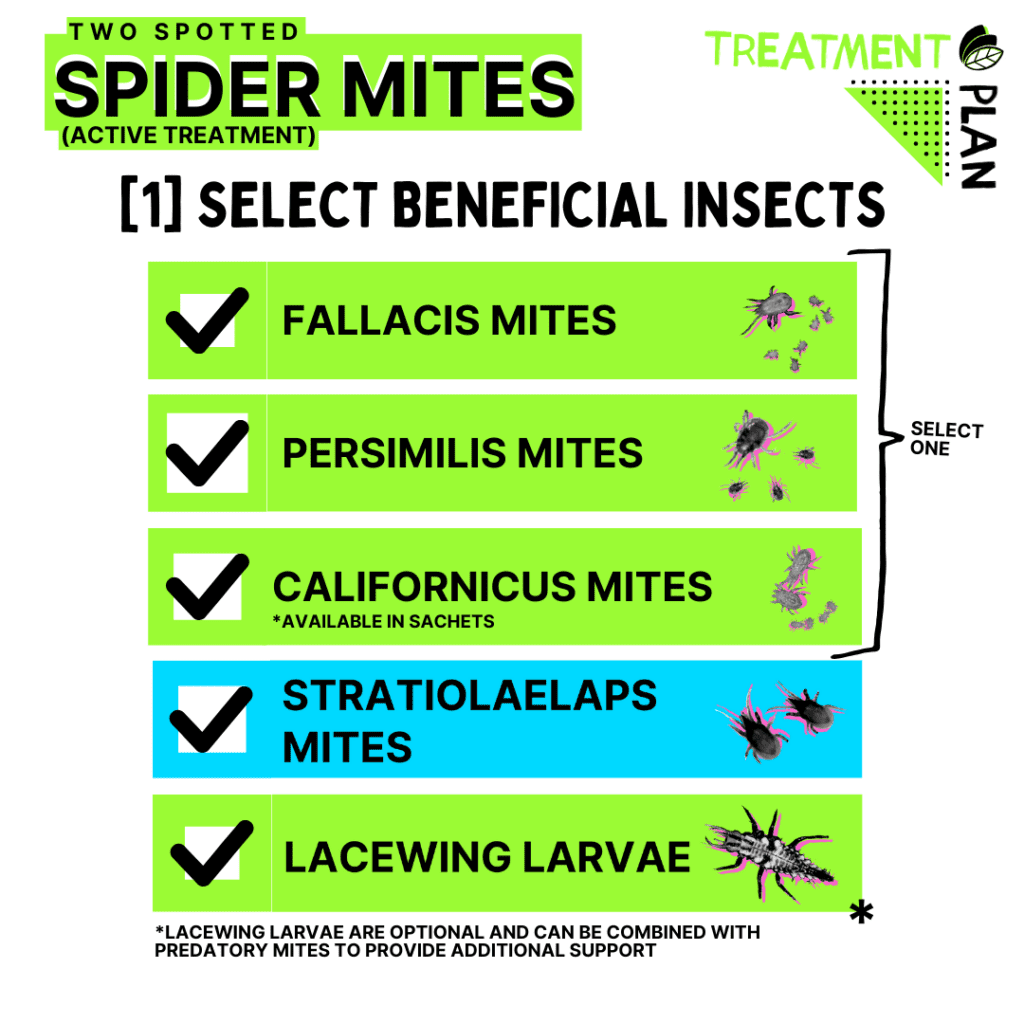
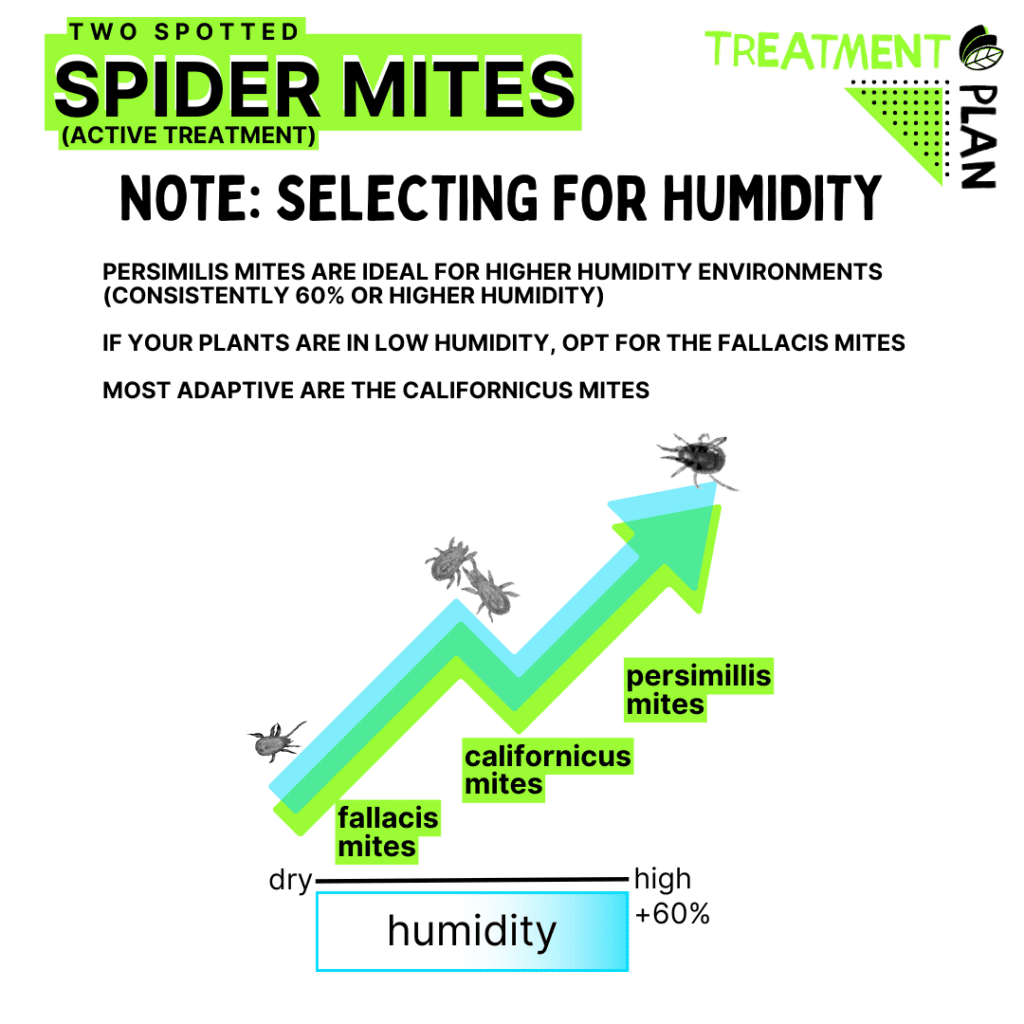

MEALYBUGS
Everyone’s favorite, fuzzy pest, mealybugs can feel like a true challenge to get rid of, and they can be quite destructive to your plants, causing overall plant decline, yellowing, and leaf drop.
Lacewing larvae are the best predator for mealybugs, though you may have to do up to three or four releases two weeks apart to get rid of them. For heavy infestations you can also use the cryptolaemus beetle, but they require a lot of food to be successful so it’s always good to partner them with the lacewing larvae for sustainable pest control over time.
SCALE
There are unfortunately no predators or pesticides that can penetrate the waxy dome that the scale lives under, but lacewing larvae will eat the juveniles that stream out from underneath the dome. Apply fresh lacewing larvae every two weeks AND manually remove any hard scale you see (pick the scale off using your hands or a toothbrush) until the scale is gone.
FUNGUS GNATS
Fungus gnats are very annoying to have but very easy to get rid of and prevent. Use yellow sticky traps to target the adult flying fungus gnats and use nematodes to treat the larvae that develop in the soil. One application of nematodes per plant should be enough to dramatically reduce or eliminate fungus gnats.

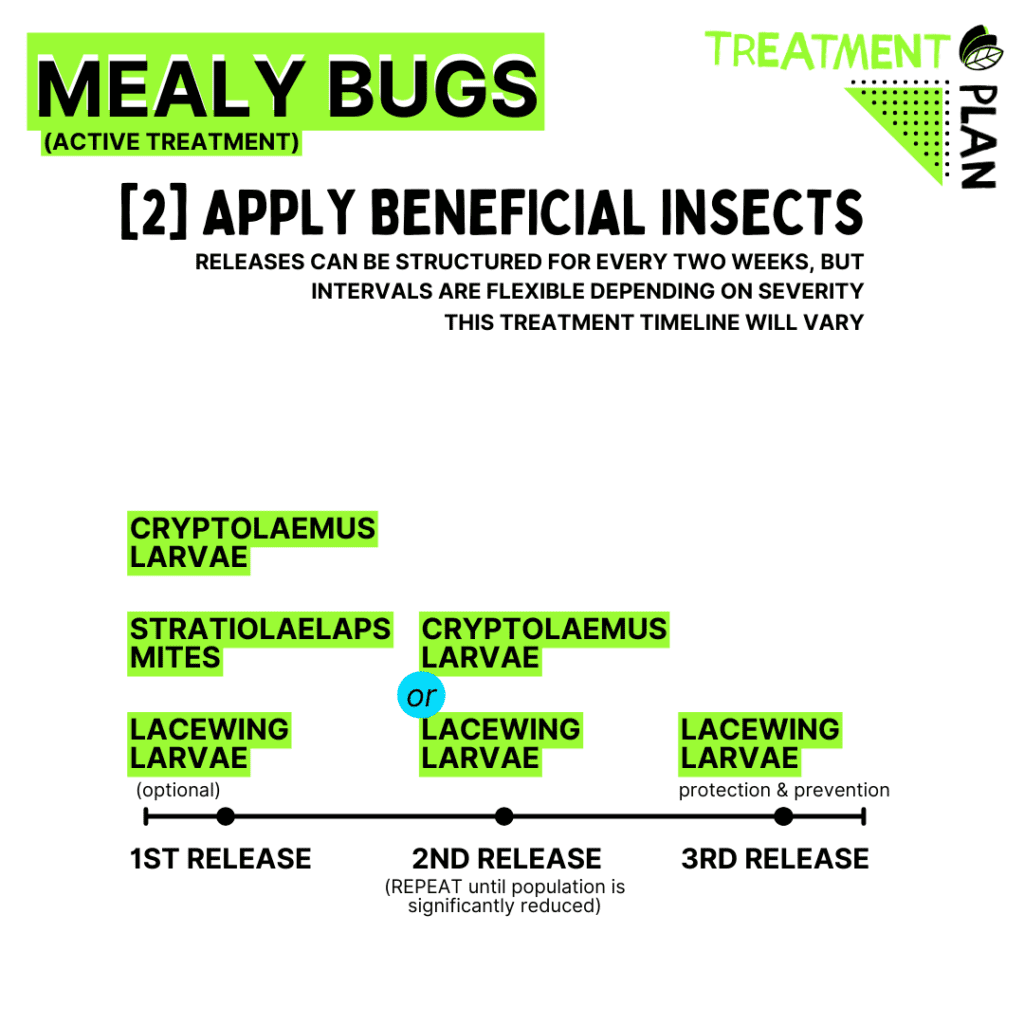

PREVENTION Treatment Plans
While most people’s first introduction to beneficial insects begins with treatment for an active issue, beneficial insects can also be used preventatively to maintain plant health and keep these problems from occurring in the first place.There are a number of approaches you can take when it comes to using beneficial insects preventatively, and it will vary depending on your specific situation (the types of plants you have, your pest history, growing style, etc) but there are some general guidelines you can use as you develop your own beneficial insect use style.
In addition to investing in quality soil and amendments, be sure to treat your soil for pests. Many of our common houseplant pests either have a stage of their life cycle in the soil, hibernate in the soil, or can be hidden in new bags of soil you bring in to pot your plants. However, you should NOT bake new soil, or pour boiling water through it to sterilize it – you’ll kill all the good soil microbes that help your plant grow and uptake nutrients. Instead, treating your entire plant population with nematodes sf at least once a year is good standard practice to prevent fungus gnats and thrips. We also highly, highly recommend the stratiolaelaps soil mites. Unlike nematodes, stratiolaelaps can be used in non-soil mediums as well (leca, moss, pon, etc). If not treating for any active pest issues, we recommend reapplying the stratiolaelaps about four times a year. They’ll prevent thrips, root mealybugs, and fungus gnats, as well as eating pathogenic fungi and bacteria.
Selecting the correct predatory mite and releasing them regularly (every four months) is a good practice for pest prevention. Check out our predator page for information on the different mites.
Since lacewing larvae are a generalist predator, releasing them regularly on your plants can help to prevent things like mealybugs, scale and aphids, as well as thrips and spider mites. Releases every three to four months is a good standard practice but you can absolutely release more or less often, depending on your comfort level, budget, peace of mind, and how your plants are doing.
In addition to investing in quality soil and amendments, be sure to treat your soil for pests. Many of our common houseplant pests either have a stage of their life cycle in the soil, hibernate in the soil, or can be hidden in new bags of soil you bring in to pot your plants. However, you should NOT bake new soil, or pour boiling water through it to sterilize it – you’ll kill all the good soil microbes that help your plant grow and uptake nutrients. Instead, treating your entire plant population with nematodes sf at least once a year is good standard practice to prevent fungus gnats and thrips. We also highly, highly recommend the stratiolaelaps soil mites. Unlike nematodes, stratiolaelaps can be used in non-soil mediums as well (leca, moss, pon, etc). If not treating for any active pest issues, we recommend reapplying the stratiolaelaps about four times a year. They’ll prevent thrips, root mealybugs, and fungus gnats, as well as eating pathogenic fungi and bacteria.
Selecting the correct predatory mite and releasing them regularly (every four months) is a good practice for pest prevention. Check out our predator page for information on the different mites.
Since lacewing larvae are a generalist predator, releasing them regularly on your plants can help to prevent things like mealybugs, scale and aphids, as well as thrips and spider mites. Releases every three to four months is a good standard practice but you can absolutely release more or less often, depending on your comfort level, budget, peace of mind, and how your plants are doing.
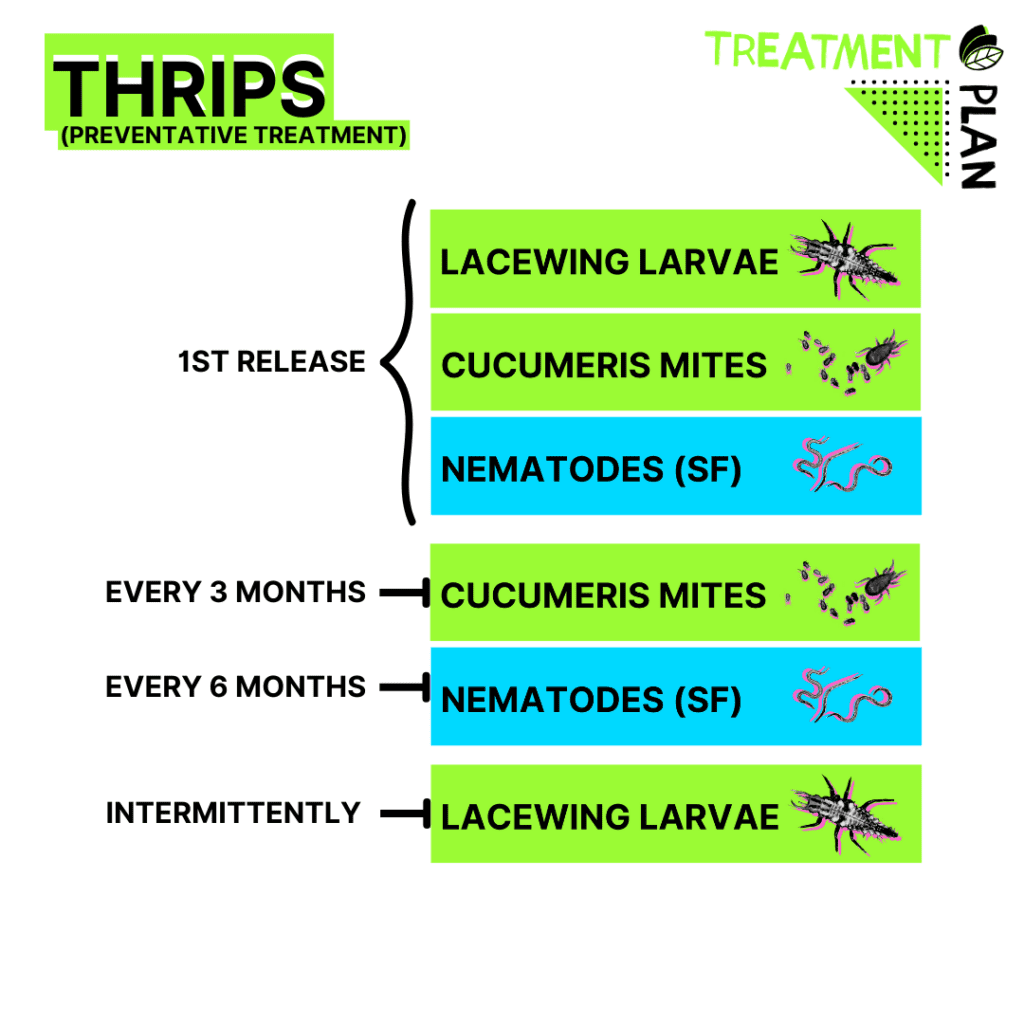
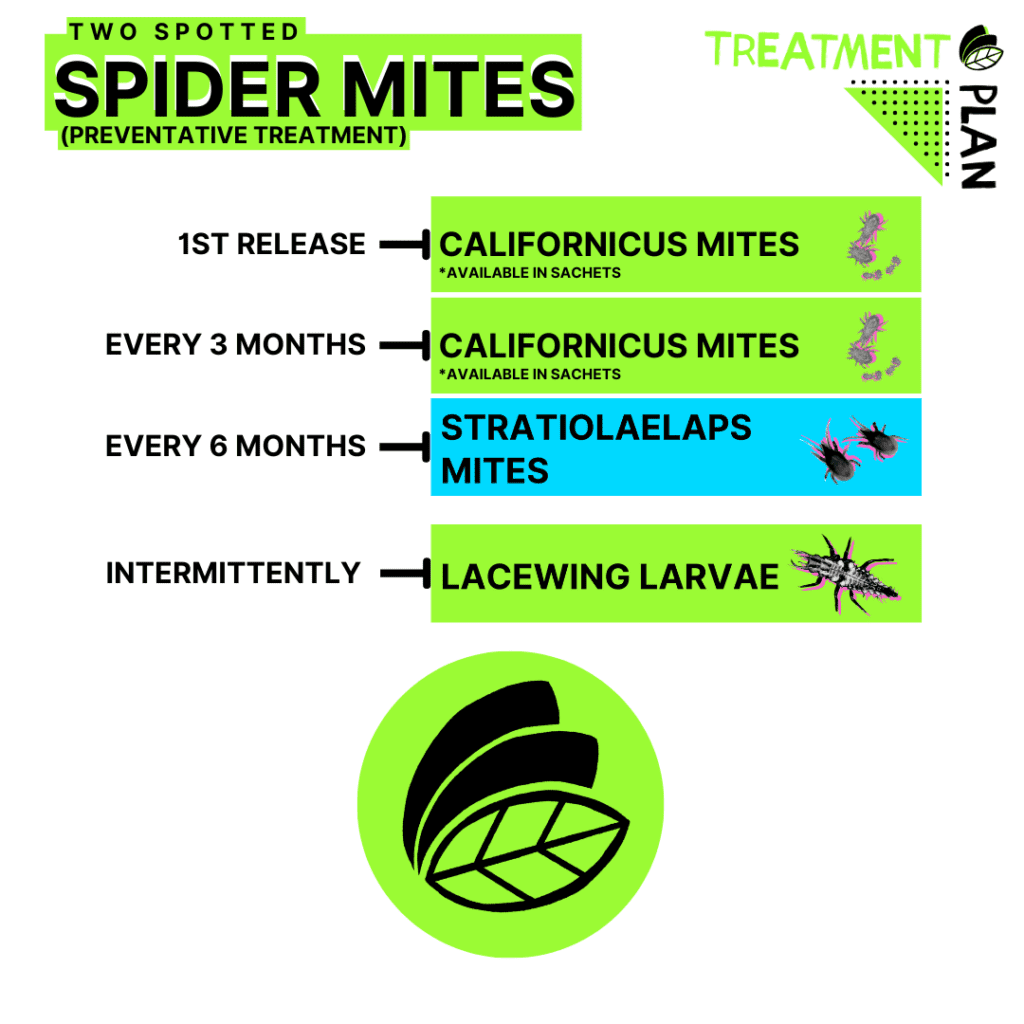
How do I know how many predators to order?
It varies depending on whether you are using the predators to treat an active pest issue or for prevention, how big your plants are, what your set up is like, what your environmental conditions are (especially humidity levels) etc.
BUT
We @dmvb have put together some graphics to give you a general estimate as to what to expect in terms of size from the various products.
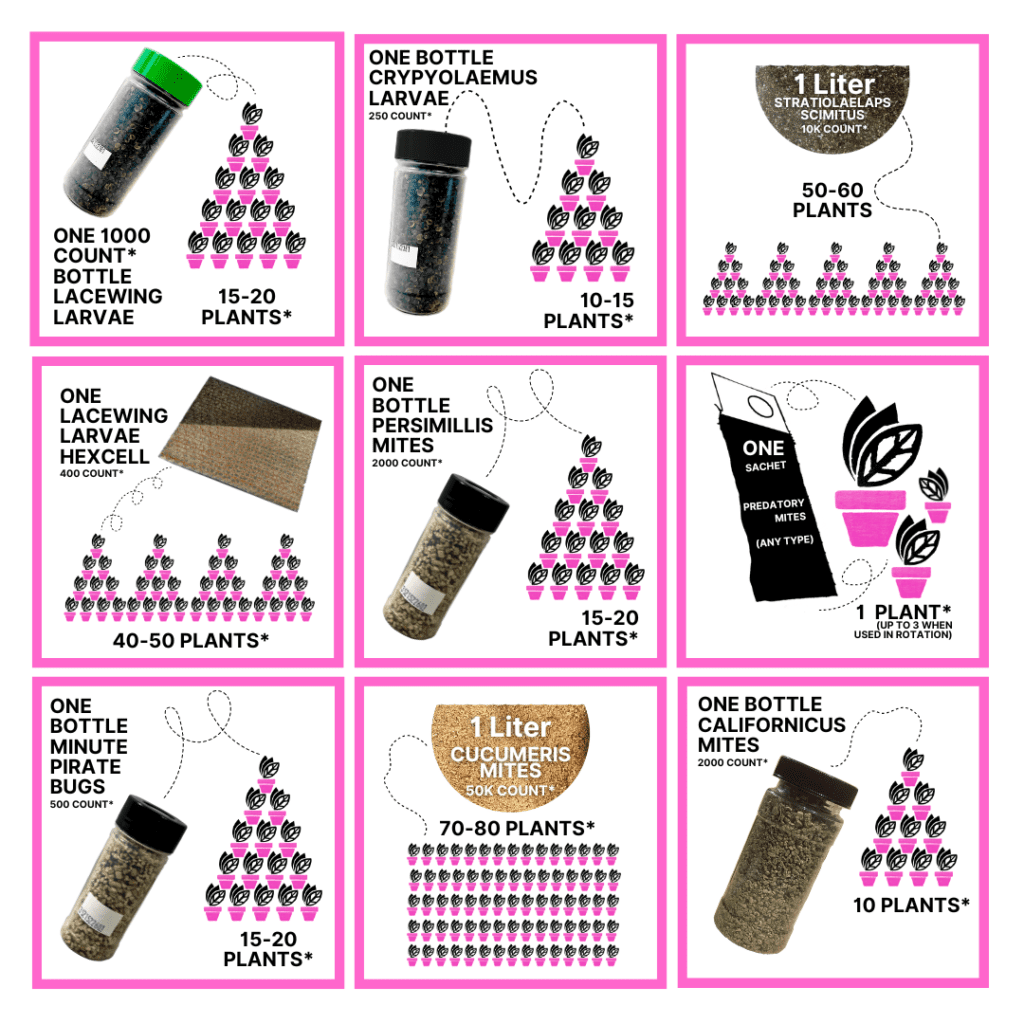
*When we say “number of plants”
We are using a six inch plant as the average size. If your plants are bigger you would be able to treat less with each product, for example
These estimates also assume an average level of pests – if you’re using them for prevention alone they will go father and if you have a bad pest issue you may want to concentrate these sizes where the trouble spots are.





